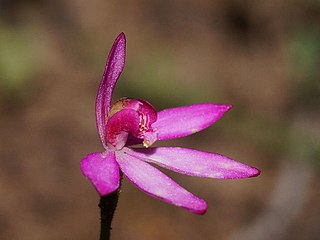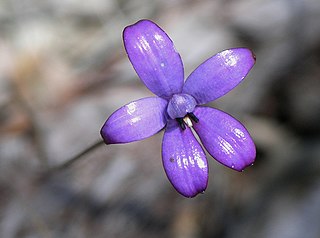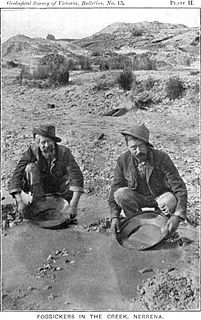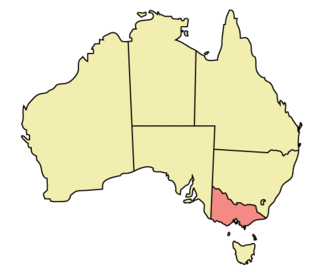
Caladenia picta, commonly known as painted fingers, is a species of orchid endemic to New South Wales. It has a single, sparsely hairy leaf and a single white or pink flower with a greenish-white back. Unlike many other caladenias, it flowers in autumn.

Caladenia gracilis, commonly known as musky caps or musky caladenia, is a plant in the orchid family Orchidaceae and is endemic to eastern and south-eastern Australia, including Tasmania. It is a ground orchid with a single leaf and up to six flowers which are dark-coloured on the back and white on the front, sometimes tinged with pink and with a strong musky or soapy odour. The species is also known as Caladenia moschata in Victoria.

Caladenia ampla, commonly known as the dainty spider orchid, is a plant in the orchid family Orchidaceae and is endemic to Victoria. It is a ground orchid with a single hairy leaf and a single flower which is sometimes yellowish-green flower with red stripes and sometimes entirely red.
Caladenia cretacea, commonly known as Stuart Mill spider orchid, is a plant in the orchid family Orchidaceae and is endemic to a small area in Victoria. It is a rare ground orchid with a single leaf and one or two white flowers on a hairy stalk.

Caladenia fragrantissima, commonly known as the scented spider orchid, is a plant in the orchid family Orchidaceae and is endemic to Victoria and South Australia. It is a ground orchid with a single hairy leaf and up to three creamy-white to yellowish-green flowers. It is possible that it is conspecific with Caladenia orientalis.
Caladenia hastata, commonly known as Mellblom's spider orchid is a plant in the orchid family Orchidaceae and is endemic to Victoria. It is a ground orchid with a single hairy leaf and up to three white to cream-coloured flowers with red markings on the labellum.

Caladenia hildae, commonly known as golden caps, honey caladenia or honey hood is a plant in the orchid family Orchidaceae and is endemic to the south-east of mainland Australia. It is a ground orchid with a single leaf and up to four yellowish-brown to golden-brown flowers with darker tips on the sepals and petals.
Caladenia magnifica, commonly known as the magnificent spider orchid is a species of orchid endemic to Victoria. It has a single leaf and one or two reddish crimson or yellow flowers streaked with crimson and with dark reddish tips. It has not been sighted since 1979 and is presumed to be extinct.

Caladenia moschata, commonly known as musky caps or musky caladenia, is a plant in the orchid family Orchidaceae and is endemic to eastern and south-eastern Australia, including Tasmania. It is a ground orchid with a single leaf and up to five flowers which are dark-coloured on the back and white on the front, sometimes tinged with pink and with a strong musky or soapy odour. The species was previously known as Caladenia gracilis.
Caladenia oreophila is a plant in the orchid family Orchidaceae and is endemic to south-eastern Australia. It is a ground orchid with a single leaf and a single greenish-cream flower with pale red stripes a red labellum with a greenish-cream base.

Caladenia ornata, commonly known as ornate pink fingers is a species of orchid endemic to Victoria. It has a single leaf and one or two bright pink flowers with greenish-pink backs, and a dark pink labellum with dark red bars.
Caladenia osmera is a plant in the orchid family Orchidaceae and is endemic to south-eastern Australia. It is a ground orchid with a single leaf and one or two greenish-cream flowers with pink stripes and which has a sharp odour resembling burnt plastic.
Caladenia peisleyi is a plant in the orchid family Orchidaceae and is endemic to south-eastern Australia. It is a ground orchid with a single leaf and a single greenish-yellow flower with pale red stripes. It is difficult to distinguish from several other Caladenia species.
Caladenia pilotensis is a plant in the orchid family Orchidaceae and is endemic to Victoria. It is a ground orchid with a single leaf and one or two white or creamy-white flowers which sometimes have red lines. It is only known to occur on a single mountain.
Caladenia pumila, commonly known as the dwarf spider orchid is a plant in the orchid family Orchidaceae and is endemic to Victoria. It is a ground orchid with a single erect, hairy leaf and a single white flower with pale pink stripes. Its short flowering stem distinguishes it from other Victorian spider orchids. After 1933 it was presumed extinct until two plants were discovered in 2009.

Caladenia rosella, commonly known as the rosella spider orchid is a plant in the orchid family Orchidaceae and is endemic to south-eastern Australia. It is a ground orchid with a single hairy leaf and a single scented pink flower. Although it may have had a wider distribution in the past, the total number of plants in 2000 was estimated to be 120 in four populations in Victoria. There is a single record from New South Wales but the orchid is classified as "extinct" in that state.

Caladenia valida, commonly known as the robust spider orchid, is a plant in the orchid family Orchidaceae and is endemic to south-eastern continental Australia. It is a ground orchid with a single sparsely hairy leaf and up to three white to cream-coloured flowers which sometimes have red streaks. It is similar to Caladenia reticulata but is large and taller with more stiffly spreading lateral sepals and petals.
Caladenia gracillima, commonly known as pretty fingers, is a species of orchid endemic to eastern Australia. It has a single leaf and up to three bright pink flowers. The type specimen was collected at Yandina in southern Queensland but there are also records from southern New South Wales.

Caladenia brunonis, commonly known as the purple enamel orchid, is a plant in the orchid family Orchidaceae and is endemic to the south-west of Western Australia. It is a ground orchid with a single flattened, hairy leaf and up to three glossy purple flowers. It has recently been known as Elythranthera brunonis since 1963 but recent discoveries suggest its inclusion in the genus Caladenia.

Caladenia emarginata, commonly known as the pink enamel orchid, is a plant in the orchid family Orchidaceae and is endemic to the south-west of Western Australia. It is a ground orchid with a single flattened, hairy leaf and up to four glossy pink flowers. It is similar to Caladenia brunonis but is usually a shorter plant but with larger, pink flowers. It has been known as Elythranthera emarginata since 1963 but recent discoveries suggest its inclusion in the genus Caladenia.





















